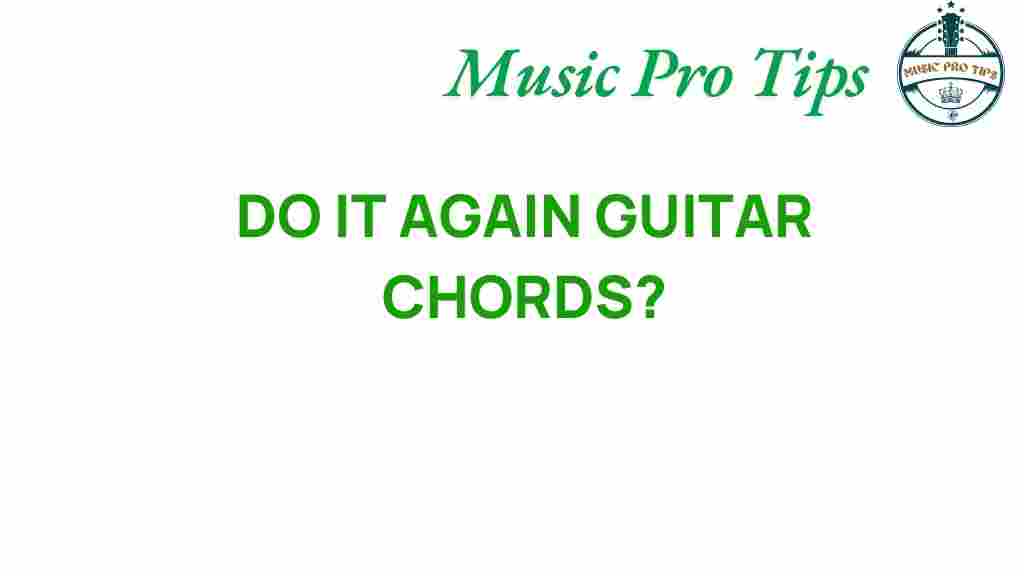Unlocking the Secrets of Do It Again Guitar Chords
For many aspiring musicians, the journey begins with learning guitar chords. Among the myriad of songs that can be played on the acoustic guitar, “Do It Again” stands out as a favorite for its catchy melody and relatable lyrics. Understanding the guitar chords for this song not only enhances your playing skills but also deepens your grasp of music theory and chord progressions. In this article, we’ll explore the guitar chords used in “Do It Again,” along with practical tips for beginner guitarists, songwriting techniques, and creative practices to enhance your musical journey.
Understanding Music Theory: The Basics of Chord Progressions
Before diving into the specific guitar chords for “Do It Again,” let’s take a moment to understand the fundamental principles of music theory that relate to chord progressions. A chord progression is a sequence of chords played in succession, forming the harmonic backbone of a song.
What Are Chords?
Chords are combinations of notes played simultaneously. They are categorized based on their construction and function within a piece of music:
- Major Chords: Bright and happy sounding.
- Minor Chords: More somber or melancholic in tone.
- Seventh Chords: Add a jazzy flavor, often used in blues and jazz.
Common Chord Progressions
Many songs, including “Do It Again,” utilize common chord progressions. Some of the most frequently used progressions include:
- I-IV-V: A classic progression found in countless songs.
- ii-V-I: Common in jazz, creating tension and resolution.
- I-V-vi-IV: Popular in pop music, creating a catchy and memorable sound.
The Guitar Chords for “Do It Again”
Now, let’s focus on the specific guitar chords used in “Do It Again.” The song primarily revolves around a simple chord progression that makes it accessible for beginner guitarists.
Chords Used in the Song
The primary guitar chords for “Do It Again” include:
- C Major
- G Major
- A Minor
- F Major
Chord Diagrams
Here are the chord diagrams for each of the chords:
C Major:
e|-0-B|-1-G|-0-D|-2-A|-3-E|-x-
G Major:
e|-3-B|-3-G|-0-D|-0-A|-2-E|-3-
A Minor:
e|-0-B|-1-G|-2-D|-2-A|-0-E|-x-
F Major:
e|-1-B|-1-G|-2-D|-3-A|-3-E|-1-
Playing the Chord Progression
To play “Do It Again,” you can follow this chord progression throughout the song:
C - G - A minor - F
Repeat this progression for different sections of the song, adjusting your strumming pattern to match the feel of the music. A simple down-up strumming pattern will work well for beginners.
Strumming Techniques for Beginners
As a beginner guitarist, mastering strumming techniques is crucial for playing smoothly. Here are a few tips:
- Keep It Simple: Start with a basic down strum.
- Practice Rhythms: Use a metronome to stay in time.
- Experiment: Try different patterns, such as down-up, down-down-up.
Songwriting and Creative Practice
Once you’ve mastered the guitar chords for “Do It Again,” you might feel inspired to create your own music. Here are some songwriting techniques that can help you harness your creativity:
1. Explore Different Chord Progressions
Experiment with various chord progressions beyond the one used in “Do It Again.” This will not only enhance your skills but also allow you to develop your unique sound.
2. Incorporate Music Techniques
Use techniques such as:
- Suspended Chords: Add tension that resolves into major or minor chords.
- Inversions: Change the bass note to create different textures.
- Capo Usage: Transpose songs to suit your vocal range.
3. Creative Practice
Dedicate time to practice creatively. This can include:
- Jamming: Play along with backing tracks or with friends.
- Improvisation: Make up melodies over the chord progressions you know.
- Writing Lyrics: Pair your chords with lyrics that resonate with your experiences.
Troubleshooting Tips for Beginner Guitarists
As you learn to play the guitar chords for “Do It Again,” you may encounter challenges. Here are some troubleshooting tips to help you overcome common issues:
1. Difficulty Changing Chords
If you find it hard to switch between chords smoothly:
- Practice switching between two chords at a time before adding more.
- Use a metronome to gradually increase your speed.
2. Muted Strings
Muted strings can be frustrating when strumming:
- Check your finger placement; ensure you’re pressing down firmly on the strings.
- Adjust the angle of your hand to avoid accidentally touching other strings.
3. Strumming Rhythm Issues
If your strumming feels off-beat:
- Practice with a metronome to develop a solid sense of timing.
- Slow down your strumming until you feel comfortable, then gradually increase the speed.
Conclusion
Mastering the guitar chords for “Do It Again” is an excellent way to enhance your playing skills while exploring the fundamentals of music theory, chord progressions, and songwriting. By incorporating creative practices and troubleshooting tips, you can confidently express yourself through music. Remember, every guitarist starts as a beginner, and with consistent practice and exploration, you’ll unlock your full musical potential.
For more resources on guitar techniques, check out this helpful guide. And for inspiration and tutorials, visit this website.
This article is in the category Theory and created by MusicProTips Team
